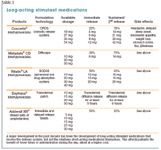Getting to know your Headmeds
Administering a psychotropic med to a young patient can be an uneasy venture, but you can build your comfort level through review.

Keypoints:
Controversy amid safety issues, questionable long-term effects, and limited mental health training have driven pediatricians to shy away from prescribing psychotropic medications. While understandable, this creates a potential burden to youth who are in need of care. Pediatricians looking to remedy this situation often rely on a referral to a child/adolescent mental health specialist. But timely access to this group can be challenging, due to the low number of providers in this subspecialty. In the end, the decision to prescribe psychopharmacologics to your young patient may indeed rest in your hands, so preparation is key.
This article examines the most common child and adolescent psychiatric conditions in which the use of psychotropic medication is well established, with the goal of helping pediatricians choose from effective treatments. This article assumes that medications are prescribed in accurately diagnosed children who are receiving comprehensive and integrated treatment, including psychoeducational assessment, liaison with school systems, and individual and family psychotherapy. Of course, initiation of any psychotropic medication requires discussion with your patient and their parents surrounding the risks and benefits of this therapy.
Attention-deficit hyperactivity disorder
Despite the success of stimulants in ADHD treatment routines, mistakes in their administration continue to occur. At the top of the list is initiating with a low dose and not titrating upward, or not moving into another class of stimulant if there is no apparent benefit from the first stimulant. Dosing should begin low, typically 5 mg/day of amphetamine preparations or dexmethylphenidate (a stimulant consisting of the dextroisomer of methylphenidate), or 10 mg/day of methylphenidate. This should be followed by titration, which can be done fairly quickly, with dose changes every four to seven days. Baseline pulse and blood pressure should be recorded at each increase, and then every six months thereafter. Weight and height should also be charted at baseline, then at least every six months, using a growth chart.

In the recent Preschool ADHD Treatment Study (PATS) of children aged 3 to 5, methylphenidate demonstrated its efficacy, but with a lower effect size and a higher rate of side effects as compared to studies in older populations.3 The optimal dose of methylphenidate varies from child to child. In the PATS study, the mean dose of methylphenidate was 14 mg/day. In the comprehensive multimodal ADHD treatment (MAT) study, the mean dose of methylphenidate was 35 mg/day.4